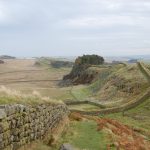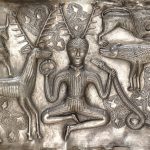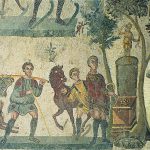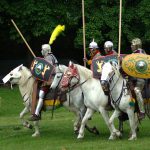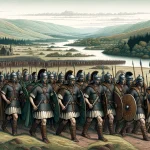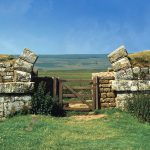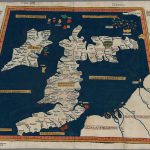The Brigantes were loose confederation of tribes who in pre-Roman times controlled the largest section of what would become Northern England. Their territory, often referred to as Brigantia, was centred in what was later known as Yorkshire.
The Brigantes Geographic Area
“Below the Selgovae and Otalini are the Brigantes extending to both seas, among whom are the following towns: Epiacum 18*30 58°30 Vinovium 17*45 58°00 Caturactonium 20*00 58°00 Calatum 19*00 57°45 Isurium 20*00 57°40 Rigodunum 18*00 57°30 Olicana 19*00 57°30 Eboracum, Legio VI Victrix 20*00 57°20 Camulodunum 18*00 57°45.”
The Geographia of Ptolemy (II.ii)
The Brigantes tribe occupied/inhabited the whole of North-East England with exception of Humberside, which was inhabited by the Parisi, and Cumbria, which was occupied by the Carvetii. They built small, fortified hill crofts but very few hill-forts. They were probably a federation of smaller states, once independent but at some time uniting under a single tribal banner. The federation may have included the lands of the Setantii, Parisi and the Carvetii.
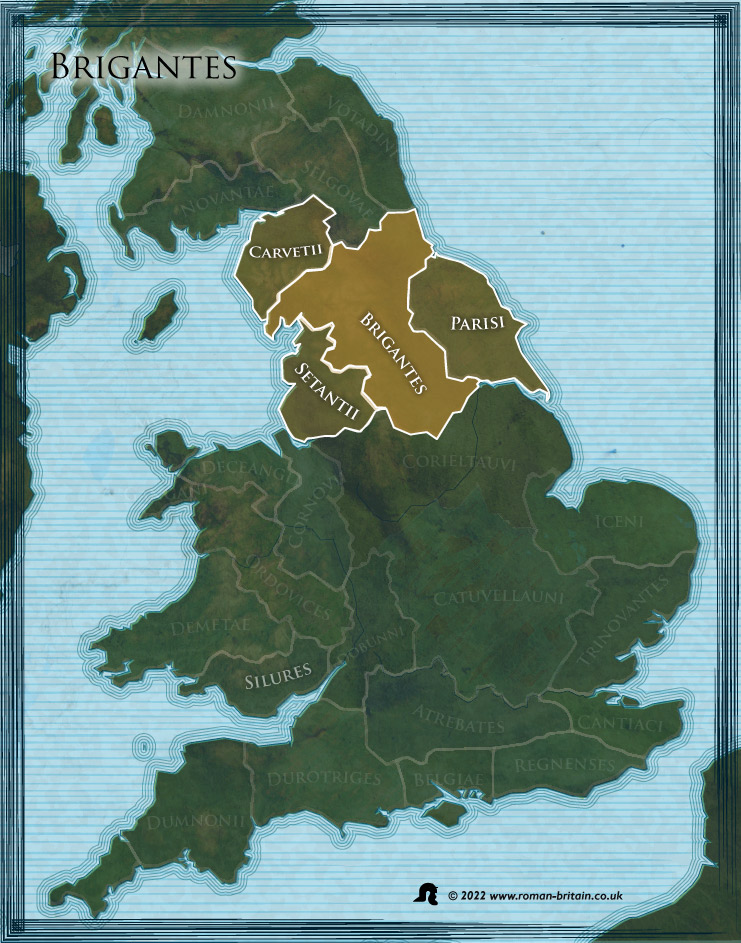
It is possible that the vast earthworks still visible at Stanwick Camp on the North Yorkshire Moors was a moot of the tribe, a place where the widely-separated branches of the Brigantean federation would meet once a year to exchange goods and livestock, to bandy tall tales and to arrange marriages between their children.
Other passages in Ptolemy Book II Chapter 2 give the ancient names of a number of rivers and other geographical features within the territories of the Brigantes tribe:
- Tinea Fluvius (River Tyne) is thought to have formed the north-eastern boundary of the tribal lands, separating the Brigantes from the Votadini tribe in Northumbria.
- Vedra Fluvius (River Wear) empties into the North Sea at Sunderland.
- Dunum Sinus (Tees Bay) between modern Hartlepool and Redcar. The name may be translated as ‘The Bay of the Fortification’ but it is uncertain as to which fortified settlement is meant.
- Abus Fluvius (River Humber) may have once formed the south-eastern tribal boundary between the Brigantes and the Coritani of Lincolnshire, before the Parisi moved into North Humberside.
- Seteia Aestuarium (Mersey Estuary) marked the south-western boundary of the Brigantes, separating them from the Cornovii in Cheshire.
- Belisama Fluvius (River Ribble) is thought to have formed the southern boundary of a minor tribal sect, the Setantii, who inhabited the area of modern Blackpool and the Fylde.
- Moricambe Aestuarium (Morecambe Bay) on the west coast of Lancashire probably marked the border with the Carvetii .
Settlements of the Brigantes
The Civitas Brigantum The Principal Tribal Centre
Aldborough (Isurium Brigantum)The Nine Tribal sites Assigned by Ptolemy
- Whitley (Epiacum)
- Binchester (Vinovia) Fort
- Cataractonium Settlement
- Burrow (Calacum) Roman Fort
- Aldborough (Isurium Brigantum)
- Castle Shaw (Rigodunum)
- Elslack (Olenacum)
- Eburacum (York)
- Slack (Cambodunum)
Other Tribal Settlements
- Ribchester (Bremetenacvm Veteranorvm) – A number of Sarmatian veterans were settled here, probably by Antoninus Pius following a Brigantian revolt mentioned by Pausanias.
- Calcaria – Assigned to the Brigantes in the Antonine Itinerary and the Ravenna Cosmography.
- Slack (Cambodunum) Roman Fort – South-west of Tadcaster, along the road to Slack and Manchester. Mentioned in the Antonine Itinerary. Roman name transferred from the Brigantian hillfort at Castle Hill, Almondbury, near Huddersfield.
- Whitby (Dictium) Signal Station – Sea-Jet for votive carvings and personal ornaments was collected from the beach here, but no settlement has been identified.
- Adel – Small civil settlement.
According to Lempriere, the word Briga or Brica was used by the ancient inhabitants of Gaul and Germany simply to signify a town or settlement. Although this could be the root of the tribal name, the Briga- prefix in this instance probably refers to the British goddess Brigit. This deity is often associated with the Roman Minerva, Greek Athene, and probably the Irish Morrigan, all fertility-curative-knowledge deities. She was perhaps also known by the name Brigantia.
The name Brigantes, then, should be translated ‘The People of Brigit’.
Briga- Prefixed Names in Europe
- Brigantes Major tribe of Northern Britain. Tribal capital Isurium Brigantum. (22CDb)
- Brigantii People of Central Raetia whose tribal capital named Brigantium was situated on the south-east shore of the Brigantinus Lacus. Another of their major towns was Cambodunum. (23HJd)
- Brigantinus Lacus A lake in Raetia in the Alps, now known as Lake Constance, through which the River Rhine flows. (23Hd)
- Brigantium Raetiae Tribal capital of the Brigantii situated on the eastern shores of Brigantinus Lacus in Central Raetia. Now known as Bregentz on Lake Constance in the Austrian Tyrol. (23Hd)
- Brigantio Roman settlement in the Cottian Alps. (23Ge)
- Brigantium Hispaniae also known as Brigantinus Portus, was the ancient name of the seaport of Corunna in north-western Spain. A major settlement of the northern Gallaeci tribe, was situated in the conventus Lucensis, part of the province of Gallia Tarraconensis. This seaport was the western terminus of a major trade route in tin, gold, lead and silver. (25aBa, 30aDe)
The codes within brackets in the above list refer to the maps and grid-references in Atlas of the Greek and Roman World in Antiquity by Nicholas G.L. Hammond.
Shrines to the deity Brigantia in Britain
Brigantia was the patron deity of the Brigantes tribe and was also venerated throughout the iron-age world under the names of Birgit, Brigit and Bride. She was the three-fold goddess of wisdom, known as the ‘Mother of Memory’, a daughter of Dana the Iron-age mother goddess. Many of her altars are conflated with Victoria or Nike and demonstrate that she must have shared some attributes with these martial goddesses.
- Slack, Outlane (623 [Bregantia et Num Aug]);
- Greetland (627 [208AD; Victoria Brigantia et Num Aug]);
- Castleford (628 [Victoria Brigantia]);
- Adel (630 [deae Brigan]);
- South Shields (1053);
- Corbridge (1131 [Iovi Aeterno Dolicheno et Celestial Brigantia]);
- Hadrian’s Wall (2066 [212-17AD, Nymphae Brig]);
- Birrens (2091).
Brigantian History from the Classics
A revolt in Brigantia is quelled by Ostorius Scapula 47AD
After devastating the lands of the Deceangi in north-east Wales, Scapula prepared to assault the island of Mona, or Anglesea, off the north-west coast of Wales.
‘… Ostorius was within measurable distance of the sea which looks towards the island of Hibernia [Ireland], when an outbreak of sedition among the Brigantes recalled a leader who was firm in his resolution to attempt new conquests only when he had secured the old. The Brigantian rising … subsided on the execution of a handful of men, who were beginning hostilities, and the pardon of the rest; …’
Tacitus, Annales Book 12 Chapter 32
Following this internecine struggle among the Brigantes, the clientship of Rome was conferred upon Queen Cartimandua, who, along with her consort Venutius, were to rule the Brigantes for the next few years in comparative quiet.
Cartimandua surrenders Caratacus to Ostorius 51AD
A test of Cartimandua’s loyalty to emperor Claudius in Rome came after the crushing defeat of the British warlord Caratacus in mid-Wales by the Roman legate Ostorius Scapula.
Tacitus Annales xii.36
‘Caratacus himself … after seeking the protection of the Brigantian queen Cartimandua, was arrested and handed to the victors, in the ninth year from the opening of the war in Britain. …’
Caratacus was led in triumph by Claudius through the streets of Rome some time in the autumn of 51AD, and the ornaments of a triumphant general were conferred upon Ostorius, without him actually celebrating a triumph himself, which honours were reserved exclusively for the imperial house.
The Uprising of Venutius is Quelled by Didius Gallus c.55/56AD
Following the betrayal of Caratacus, all was not well in Brigantia, and dissentions were being voiced, particularly it would seem, from Venutius, the prince-consort of Cartimandua. Though unproven, it is thought that Venutius hailed from the Carvetii , an influential sub-tribe of the Brigantian Federation who inhabited the area in and around the modern county of Cumbria in north-west England, including parts of Durham and south-west Scotland; it is very likely that the lost part of Tacitus’ Annals would have confirmed this assumption (see footnote below).
Tacitus Annales xii.40
‘… Since the capture of Caratacus, however, the Briton with the best knowledge of the art of war was Venutius, whose Brigantian extraction has been mentioned earlier.¹ He had long been loyal, and had recieved the protection of Roman arms during his married life with Queen Cartimandua: then had come a divorce, followed by immediate war, and he had extended his hostility to ourselves. At first, however, the struggle was confined to the pair; and Cartimandua adroitly entrapped the brother and family connections of Venutius. Incensed at her act, and smarting at the ignominious prospect of submitting to the sway of a woman, the enemy – a powerful body of young and picked warriors – invaded her kingdom. That event had been forseen by us, and the cohorts sent to the rescue fought a sharp engagement, with dubious results at the outset but a more cheerful conclusion. …’
- The previous reference in the Annals is now lost.
Following his domestic dispute and subsequent escapade with the Roman military, Venutius could not remain at the court of Cartimandua and would have been forced to retire to his own lands in the north. This is not documented in any of the classics, but seems to be the only logical conclusion. The Roman intervention led by Gallus was to see peace amongst the Brigantes for the next decade or so.
The Revolt of Venutius 69/70AD
It is obvious that relations between the royal couple were to deteriorate significantly in the intervening years, for the ageing queen had a scandalous affair which rocked the Brigantian court, and eventually led to the Roman governor Vettius Bolanus being replaced by a more forceful general.
‘Inspired by these differences between the Roman forces and by the many rumours of civil war that reached them, the Britons plucked up courage under the leadership of Venutius, who, in addition to his natural spirit and hatred of the Roman name, was fired by his personal resentment toward Queen Cartimandua. She was ruler over the Brigantes, having the influence that belongs to high birth, and she had later strengthened her power when she was credited with having captured King Caratacus by treachery and so furnished an adornment for the triumph of Claudius Caesar. From this came her wealth and the wanton spirit which success breeds. She grew to despise her husband Venutius, and took as her consort his squire Vellocatus, whom she admitted to share the throne with her. Her house was at once shaken by this scandalous act. Her husband was favoured by the sentiments of all the citizens; the adulterer was supported by the queen’s passion for him and by her savage spirit. So Venutius, calling in aid from outside and at the same time assisted by a revolt of the Brigantes themselves, put Cartimandua in an extremely dangerous position. Then she asked the Romans for protection, and in fact some companies of our foot and horse, after meeting with indifferent success in a number of engagements, finally succeeded in rescuing the queen from danger. The throne was left to Venutius; the war to us.’ (Tacitus Historia iii.45)
Partly Annexed by Petilius Cerialis 71-74AD
Since the legitimate monarch of the Brigantes, a client of Rome, had been forcibly removed from her throne, Brigantia for the first time was to feel the full wrath of the Roman military machine. Petillius Cerialis, recently victorious against the renegade Julius Civilis in Lower Germany, was sent to Britain with a new legion, the Second Adiutrix, and immediately launched a campaign against the northern tribe.
‘When Britain with the rest of the world was recovered by Vespasian, … Petillius Cerialis at once struck terror into their hearts by invading the commonwealth of the Brigantes, which is said to be the most numerous tribe of the whole province: many battles were fought, sometimes bloody battles, and by permanent conquest or by forays he annexed a large portion of the Brigantes.’ (Tacitus Agricola xvii.1)
The following governor, Sextus Julius Frontinus, focussed all his attention on reducing the Silures tribe of south Wales, the Brigantes were for the moment, given respite from attack by Rome.
Conquered by Agricola during his Second Campign Season 79AD
The Silures were reduced by the campaigns of Frontinus, but the following governor, Gnaeus Julius Agricola, after finally conquering the supposed stronghold of the druids on the Isle of Mona (Anglesey), turned the focus of Rome once more upon the Brigantes.
‘When summer came he gathered his army and was present everywhere on the march, commending discipline, curbing stragglers: he chose himself the camping-ground: he was the first himself to explore estuaries and forests: meanwhile he gave the enemy no peace from the devastations of sudden raids: …’ (Tacitus Agricola xx.2)
The estuaries mentioned were those on the north-west coast of England, above North Wales; Mersey, Ribble, Lune, Kent, Deddon, Esk and Solway. Perhaps also the estuary of the Tees on the east coast.
‘By these means many states which up to that time had been independent were induced to give hostages and abandon their hostility: …’ (Tacitus Agricola xx.3)
The next chapter places Agricola the following year [80AD] at the Estuary of the Tay in southern Scotland, it would seem therefore, that the ‘many states’ mentioned were those of the Brigantes, including the Carvetii , Venutius’ own tribe, who formed the north-western part of the Brigantes federation.
Other Classical References
‘…’ (Juvenal, xiv.196)
‘…’ (Pausanias, viii.43)
An Error in Agricola?
‘A woman could lead the Brigantes to burn a colony, to storm a camp; …’ (Tacitus Agricola xxxi.4)
The Brigantes took no part in the rising of the Iceni under Boudicca in the winter of 60/61AD, and the only documented queen of the Brigantes, Cartimandua, was a client of Rome and would not have been involved in the destruction of a Roman Colonia such as happened to Camulodunum (Colchester). It is thought that the original manuscript of Tacitus here contained the word Trinobantes, and that the error was later introduced by some unknown copyist.
The Brigantian Nobility
Cartimandua
One of only two British women to be mentioned in the ancient sources, namely the Annals of Tacitus, the other being Boudicca, mentioned by Dio. She was the leading noble of the Brigantian federation who was probably granted a clientship with Rome in 43AD, along with her consort Venutius of the Carvetii. During the spring of 48AD, political pressure from certain rebels within the Brigantian nobility forced Ostorius Scapula to abandon his campaign against the Ordovices in north Wales, and turn his attention to the Brigantes (Tacitus Annals XII, 32). In 51AD Cartimandua tricked and captured the Catuvellaunian warlord Caratacus, then honoured her agreement with Rome by surrendering him to Scapula, who was still governor (Tacitus Annals XII, 36). This action seems to have stirred up some resentment towards the rule of Cartimandua within the Brigantian nobility, which for a period, lurked beneath the surface of the seemingly calm tribal pool. In circa 53AD, however, Venutius divorced Cartimandua and formed a faction of his own amongst his Carvetian tribespeople, attacking Cartimandua’s power-base and causing the new Roman governor, Aulus Didius Gallus to send a number of auxiliary cohorts to her aid (Tacitus Annals XII, 40). Cartimandua continued to rule the Brigantes for a number of years with her own armour-bearer, Vellocatus, as her consort. However, the seeds of discontent were still germinating in the ranks of the Brigantian ruling houses for another rebellion occurred during the governorship of Marcus Vettius Bolanus around 70AD. During this uprising, Cartimandua had to be rescued by an ala of Roman auxiliary cavalry sent specifically for this purpose by the governor who was occupied against the Silures in south Wales. This continuing Brigantian unrest caused the emperor Vespasian to annul the clientship of the Brigantes and for the first time, they came under the direct rule of Rome.
Vellocatus
The shield-bearer of Cartimandua, who became her lover after her consort Venutius divorced her, some time around 55AD. He lived possibly until after c.70AD when another Brigantian revolution forced Cartimandua to seek the protection of the Roman governor, leading to the dissolution of the clientship and the advent of direct rule by Rome.
For further information on Venutius see the Carvetii tribal page.
What were the lands of Brigantia like?
Archaeology provides the most reliable depiction of Brigantian society before and during the Roman invasion of Britain. This supports Tacitus’ assertion that the Brigantes were the dominant group in northern England at the time. Brigantia was centered in the Vale of York and encompassed the Pennines and the Lake District. The Pennines were rugged and divided the region north to south, but valleys and plains broke up the landscape. Some lowlands were suitable for growing cereal crops, while most of the land was used for grazing livestock. The fertile lowlands created divisions that isolated various subgroups within Brigantia due to the difficult highlands, moors, and bogs. The variations in material culture also intensified these divisions, with the more remote areas maintaining strong elements of the indigenous Bronze Age culture, while the relatively accessible regions were more heavily influenced by the Hallstatt and La Tene traditions.
In Late Iron Age Brigantia, the most common type of settlement was not the hill-fort or oppida as seen in the south, but instead the fortified homestead. These homesteads were typically circular or sub-rectangular in shape and enclosed by a timber palisade or bank and ditch. They usually covered an area of two acres or less and contained one to four separate structures. The homesteads were well fortified, which suggests that there was no centralized military force to provide protection against small-scale raids or suppress internal conflicts. This pattern of fortification also indicates that there was no readily available place of refuge outside of the individual homestead. Additionally, the relatively similar size and wealth of the homesteads suggests a diffuse society without significant social differentiation. The fact that most craft production was limited to the individual homesteads further implies limited economic specialization.
In contrast to southern Britain, Late Iron Age Brigantia did not have many settlements larger than fortified homesteads. Hill forts, when found, were small and mostly abandoned before the first century AD. The only significant exception is Stanwick, a 700-acre site that was occupied during the first century AD and has a unique function and chronology still under debate. This site’s wealth and Romanization are evident from the extensive Roman imports found there from the 40s. Despite this, there were very few large native settlements in Brigantia, leading the Romans to choose new sites for their provincial administration instead of pre-existing settlements. There is little to no evidence of pre-Roman occupation at Aldborough (Isurium Brigantium), the later capital of the civitas of Brigantia, or at the legionary fortress at York (Eboracum).
If one were to argue that the few hill-forts and Stanwick represent aristocratic or royal strongholds, and that their decline might represent the consolidation of centralized power, there are at least two issues with this position. Firstly, the absence of hill-forts could also indicate a reduction in the ability of potential rulers to impose their authority on the fortified homesteads, thereby leading to a more decentralized society. Secondly, while a large army might have been able to gather at Stanwick and intimidate others, it would have been difficult to maintain day-to-day control over the fortified homesteads without a centralized apparatus. As a result, relatively isolated groups of homesteads could have easily formed regional sub-groups with some autonomy. Archaeological evidence indicates the existence of five or six sub-groups with some certainty, out of the fifteen or so principal population concentrations known from the Roman period. Furthermore, the Romans went out of their way to route one of their roads through a particular native settlement in Brigantia, despite the rugged terrain, and built no forts in the area, implying that Rome found this area considerably more hospitable than others.
Therefore, based on the difficult terrain, the varied agricultural practices, cultural differences, the prevalence of fortified homesteads, limited economic specialization, and lack of social differentiation, it appears that Brigantia was a dispersed society made up of self-sufficient and isolated units. Additionally, inscriptions and dedications from the Roman era support the idea that Brigantia was divided into sub-groups or septs based on clusters of fortified homesteads. This archaeological and epigraphic evidence strongly suggests that Brigantia was likely a tribal federation before the Roman period, with various sub-groups based on clusters of fortified homesteads. Understanding the existence and nature of these sub-groups is critical to interpreting the Brigantian Revolt, as tribal divisions played a significant role in the relationship between Rome and Brigantia, as evidenced by Tacitus’ account of the uprising after Ostorius’ campaign into Wales and his mention of Venutius’ personal following.
During the reign of Claudius, the Romans arrived in Brigantia. Although it is challenging to determine the exact territorial extent of Brigantia and the dates of individual Roman fortifications, there is substantial evidence of pre-Flavian Roman military activity along the southern borders. A large fortress, possibly dating to the late 40s, was found at Rhyn Park in Shropshire. Although it was only occupied briefly, it was as large as a permanent legionary fortress, and along with other smaller fortresses of similar date found nearby, it may have served as a base supporting Ostorius’ operations in Wales, which resulted in the first unrest among the Brigantes, as reported by Tacitus. Additionally, several Neronian vexillation fortresses are known, and the Roman road network was expanded in the early 60s to include the area around modern-day Derby.
Archaeological evidence indicates that the Romans first entered Brigantia during the reign of Claudius. Although it is difficult to determine the exact extent of Brigantian territory and the dates of individual Roman fortifications, there is significant evidence for pre-Flavian Roman military activity along the southern borders of Brigantia. A large fortress, possibly dating to the late 40s and as big as a permanent legionary fortress, has been discovered at Rhyn Park in Shropshire, along with smaller fortresses of similar date. These fortifications may have supported Ostorius’ operations in Wales which caused the first disturbance among the Brigantes reported by Tacitus. Several Neronian vexillation fortresses are also known, and the Roman road network was expanded in the early 60s to include the area around modern Derby.
After the death of Nero in AD 68, archaeological remains of a military nature become more widespread. A series of Flavian marching-camps, all of legionary size, lie a day’s march apart and presumably followed the Roman advance into Brigantia from the territory of the Parisii, through the vale of York, and into southern Scotland. Agricola’s later campaign is marked by another series of forts built as he thoroughly garrisoned northern Britain between AD 79 and 81. Early Flavian occupation is further demonstrated by over 850 miles of roads built in Brigantia between 71-83. This combination of forts and roads brought even the most remote areas of Brigantia within range of Roman patrol, signaling the final subjugation of the area as Brigantia was incorporated into the province of Britannia.
Finally, archaeological evidence also demonstrates a degree of non-military interaction with Rome. Finds from Stanwick and Aldborough, including some fine Romano-British bronzes, indicate a degree of wealth and Romanization in Brigantia before AD 70. However, these early Roman and Romanizing finds are limited to only a few of the larger, more exceptional sites, indicating perhaps limited material exchange between the Brigantian elite and their Roman neighbours to the south.
The evidence suggests that the Brigantes were a confederacy of tribes. Additionally, Roman and Romanized artefacts found at locations like Stanwick support Tacitus’ assertion in the Agricola that Romanization and wealth were advancing in Brigantia, as in other parts of Britain. Considering both the written and physical evidence, it appears that Brigantia was a confederation of tribes within the Roman sphere before the revolt in 69-70. The Claudian fortifications indicate early Roman involvement in the late 40s, potentially leading to the peaceful submission of Brigantia to client status. An expedition in the late 50s marks the first significant Roman military engagement, while the increased building activity during the early Flavian period corresponds to the Brigantian Revolt of 69-70 and Rome’s systematic conquest of northern Britain from AD 71 to 83. Throughout this period, Romanization continued at larger sites. By 83, Brigantia had been incorporated into the Roman province of Britain.
References for The Brigantes
- The Geography of Claudius Ptolemaeus, trans. by E.L. Stevenson (Dover, New York, 1991);
- Atlas of Great Britain by the Ordnance Survey (Country Life, 1982);
- Historical Map and Guide: Roman Britain by the OS (4th Ed., 1990);
